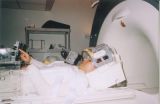(Press-News.org) Vitiligo (depigmentation of the skin) and alopecia areata (AA, patchy or complete hair loss) in patients with chronic graft-vs-host disease (GvHD) following a stem cell transplant appear to be associated with having a female donor and the sex mismatch of a female donor and male recipient.
GvHD is a frequent complication of donor stem cell transplants because donor cells can attack the recipient's body and cause death and other illnesses. The skin is the most commonly affected organ. The underlying biology of chronic GvHD has not been fully explained. The authors looked for laboratory markers, transplant-related and other factors associated with vitiligo and/or AA in patients with chronic GvHD.
The study conducted by the NIH included 282 adult and pediatric patients with chronic GvHD seen under an NIH protocol between 2004 and 2013.
A total of 15 patients (5.3 percent) from among 282 participants with vitiligo and/or AA were identified. The most common reasons for transplantation were types of leukemia. In the study group, a donor who is female, in particular a female donor and a male recipient sex mismatch, as well as the presence of certain antibodies were associated with the risk of vitiligo and/or AA.
"Although vitiligo and AA are not life threatening, the psychological consequences in patients with chronic GvHD can further impair quality of life. Future studies are needed to clarify whether the risk factors identified in this study could lead to better understanding of other autoimmune manifestations in the setting of chronic GvHD."
INFORMATION:
Author: Rena C. Zuo, B.A., of the National Institutes of Health (NIH), Bethesda, Md., and colleagues.
(JAMA Dermatology. Published online September 10, 2014. doi:10.1001/jamadermatol.2014.1550. Available pre-embargo to the media at http://media.jamanetwork.com.)
Editor's Note: This study was supported by the National Institutes of Health and other sources. Please see the article for additional information, including other authors, author contributions and affiliations, financial disclosures, funding and support, etc.
Study examines vitiligo, alopecia areata and chronic graft vs. host disease
2014-09-10
ELSE PRESS RELEASES FROM THIS DATE:
'Green wave' explains migratory bird routes
2014-09-10
Ithaca, N.Y.—Migratory songbirds enjoy the best of both worlds—food-rich summers and balmy winters—but they pay for it with a tough commute. Their twice-a-year migrations span thousands of miles and are the most dangerous, physically demanding parts of their year.
Surprisingly, for many North American species the best route between summer and winter homes is not a straight line, according to new research published in the Proceedings of the Royal Society B. In spring, the study shows, birds follow areas of new plant growth—a so-called "green wave" of new leaves and numerous ...
York U neuroscientists decode brain maps to discover how we take aim
2014-09-10
TORONTO, Sept. 10, 2014 - Serena Williams won her third consecutive US Open title a few days ago, thanks to reasons including obvious ones like physical strength and endurance. But how much did her brain and its egocentric and allocentric functions help the American tennis star retain the cup?
Quite significantly, according to York University neuroscience researchers whose recent study shows that different regions of the brain help to visually locate objects relative to one's own body (self-centred or egocentric) and those relative to external visual landmarks (world-centred ...
Happy Camp Fire in California and 790 Fire in Oregon
2014-09-10
The 790 Fire in Oregon began as a lightning strike on July 31, 2014. Over 3,000 acres have been affected by this fire which is 54% contained. In the next 12 to 48 hours there is a potential risk to Sky Lakes Wilderness and natural resources including the Northern Spotted Owl habitat, Coho habitat, water quality, the Pacific Crest Trail, and Cherry Creek Research Natural Area. Area and trail closures exist on the Pacific Crest Trail. The weather is not helping the fire fighters with gusty winds and low relative humidity. The operational objectives include keeping the ...
Diverse neighborhoods may help infants' social learning
2014-09-10
Experiencing diverse communities by hearing different languages at the park, on a bus or in the grocery store may make babies more open-minded in their social learning, a new study finds.
While previous research has shown that direct interactions with parents and caregivers shape early cognitive development, the influence of the broader community beyond those direct experiences has not been as carefully examined. In a new study published by the journal Cognition, University of Chicago Psychology Department researchers investigated whether the variety of languages in infants' ...
Will the real unemployment rate please stand up?
2014-09-10
PRINCETON, N.J.—America's unemployment rate — most recently reported as 6.1 percent — has long been used to gauge the country's economic well-being. But a new working paper released by Princeton University's Woodrow Wilson School of Public and International Affairs highlights the difficulty in estimating the exact unemployment rate, though changes in the official measure still signal important movements in the economy.
The research, published by the National Bureau of Economic Research, finds that the true unemployment rate may be higher or lower than recent reports ...
Sequencing and analysis of gibbon genome sheds light on its complex evolution
2014-09-10
PORTLAND, Ore. — A team led by an Oregon Health & Science University researcher has sequenced and annotated the genome of the only ape whose DNA had yet to be sequenced — the gibbon, an endangered small ape that inhabits the tropical forests of Southeast Asia.
The team's work, published in the Sept. 11 edition of Nature, gives scientists new insight into the evolution of the gibbon genome and its extraordinary number of chromosomal rearrangements. Chromosomal rearrangements are structural changes in the DNA that are often problematic in other species — including causing ...
Gibbon genome and the fast karyotype evolution of small apes
2014-09-10
BATON ROUGE – LSU's Mark Batzer, LSU Boyd Professor and Dr. Mary Lou Applewhite Distinguished Professor, along with Research Assistant Professor Miriam Konkel and Research Associate Jerilyn Walker in Department of Biological Sciences in the College of Science, contributed to an article featured on the cover of the scientific journal Nature, titled "Gibbon Genome and the Fast Karyotype Evolution of Small Apes."
An abstract of the article can be found at http://www.nature.com/nature/journal/v513/n7517/full/nature13679.html?WT.ec_id=NATURE-20140911. The issue of Nature will ...
NASA sees a significant flare surge off the sun
2014-09-10
The sun emitted a significant solar flare, peaking at 1:48 p.m. EDT on Sept. 10, 2014. NASA's Solar Dynamics Observatory captured images of the event.
Solar flares are powerful bursts of radiation. Harmful radiation from a flare cannot pass through Earth's atmosphere to physically affect humans on the ground. However -- when intense enough -- they can disturb the atmosphere in the layer where GPS and communications signals travel.
To see how this event may affect Earth, please visit NOAA's Space Weather Prediction Center at http://spaceweather.gov, the U.S. government's ...
Study provides more evidence that sleep apnea is hurting your brain
2014-09-10
Employing a measure rarely used in sleep apnea studies, researchers at the UCLA School of Nursing have uncovered evidence of what may be damaging the brain in people with the sleep disorder — weaker brain blood flow.
In the study, published Aug. 28 in the peer-reviewed journal PLOS ONE, researchers measured blood flow in the brain using a non-invasive MRI procedure: the global blood volume and oxygen dependent (BOLD) signal. This method is usually used to observe brain activity. Because previous research showed that poor regulation of blood in the brain might be a problem ...
Sharks more abundant on healthy coral reefs
2014-09-10
Sharks in no-fishing zones in the Great Barrier Reef (GBR) Marine Park are more abundant when the coral is healthy, according to a study published September 10, 2014 in the open-access journal PLOS ONE by Mario Espinoza from James Cook University, Australia and colleagues.
Shark species that use coral reefs may be under pressure from fishing, habitat degradation, and climate change. The authors of this study were interested in understanding the factors that affect the distribution and abundance of shark populations in the GBR, including fishing and habitat quality. To ...




